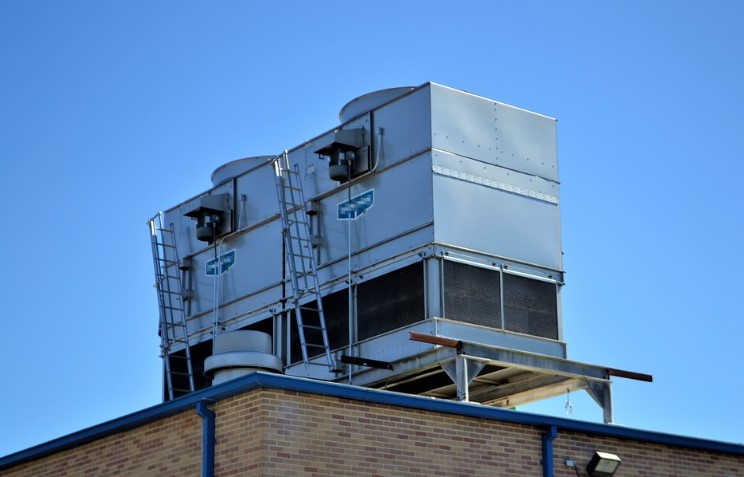
Climate control equipment on a flat roof
Modern buildings, usually, have a flat roof. This solution not only simplifies the maintenance of the roof, but also allows you to place all kinds of equipment on the roof. It can be ventilation systems, cellular communication equipment, satellite dishes, etc. Needless to say, the specified equipment needs lightning protection.
In Russia, the requirements for lightning protection of the roof are prescribed in a number of regulatory documents. First of all, these are CO-153.34.21.122-2003 "Instructions for the installation of lightning protection of buildings, structures and industrial communications". There is also RD 34.21.122-87 "Instructions for the installation of lightning protection of buildings and structures" that regulates lightning protection in more detail. Both normative documents are valid, and design organizations are allowed to use the norms of one or the other document, or their combination at their discretion.
Regulatory document RD 34.21.122-87 prescribes to protect category III residential buildings, towering above the surrounding buildings by at least 30 m, or detached buildings with a height of at least 30 m, located at least 400 m from other buildings from lightning. This regulatory document does not correspond to modern realities. In addition, now more and more common is the placement on the roofs of recreation areas, cafes, etc. of objects where people are present. Moreover, these objects are used in the summer, that is, in the season of the greatest thunderstorm activity. That is why the roof, where people are constantly present, must always be protected, and not only in the cases described in RD 34.21.122-87. The industry standard СО-153.34.21.122-2003 for ordinary objects makes it possible to independently choose one of the four levels of building protection based on the required reliability of lightning protection.
In Russia, GOST R IEC 62305 applies that is an adapted translation of the relevant international standard. The requirements for lightning rods established by this standard are in conflict with the current documents CO-153.34.21.122-2003 and RD 34.21.122-87. The reason is that both Russian and international standards do not take into account many important factors, for example, the size of the roof of the building, as well as the specific location of the lightning rod on it. According to an authoritative expert, Professor Eduard Bazelian, the development of a unified method for calculating lightning rods that has physical substantiation is still waiting for its researchers.
The use of a lightning protection grid on a flat roof
The most common way in our country to protect a flat roof from lightning is a lightning protection grid. The grid pitch should be no more than 12mx12m and should be located on non-combustible substrates or inside them. The use of the grid was intended to protect equipment underneath a non-combustible roof. The use of a lightning protection grid as a measure to prevent a lightning strike to the roof on which it is located is an ineffective measure. The grid can reliably protect only those objects that are noticeably lower than itself. This fact has been repeatedly confirmed by numerical simulation by the G.M. Krzhizhanovskii’s Energy Institute.
Very often in the construction of multi-storey buildings, reinforced concrete slabs are used as a roof. They are covered with a solid layer of waterproofing that is combustible. Obviously, it also needs to be protected from lightning. The lightning protection grid cannot provide any protection against lightning for equipment installed on the roof, because it is located below it.
The use of cable lightning rods
To use a steel cable as a lightning rod, it must be placed at a certain height relative to the objects of protection. This method is very effective, but difficult to design and install. Its greatest effectiveness is achieved when it is located outside the protected area. In order to understand its advantages, we provide the following data. For a lightning protection grid laid on a reinforced concrete roof, the probability of a lightning breakthrough is one-tenth, and for a closed cable is one-hundredth or even thousandth.
The use of lightning rods
The use of a single or double lightning rod leads to an increased load on sensitive electrical equipment inside the building. When choosing this method of protection, the height of the air terminal(s) reliably protecting the building from direct lightning strikes will significantly exceed the object of protection. A high lightning conductor increases the frequency of lightning striking it, and, therefore, dangerous electromagnetic interference to equipment increases.
Multi-electrode lightning protection on a flat roof
The so-called multi-electrode protection is much more effective when the roof is protected by a large number of lightning rods of small height. An important advantage of lightning rods is the ability to protect not only the roof, but also the equipment located on it. Lightning rods are easy to install and use. And in combination with a lightning protection grid, this solution is the most optimal, providing high reliability of protection against lightning strikes and uniform spreading of lightning currents, while improving the electromagnetic environment and reducing the risk of lightning breakdown on protected electrical equipment.
Do you need help in designing or choosing equipment for grounding and lightning protection? Contact the ZANDZ.com Technical Center!
Related Articles:
 Examples of grounding solutions
Examples of grounding solutions
 6. How to do that?
6. How to do that?

